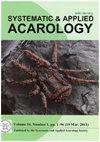阿维菌素与噻虫氯芬混合药剂对威氏弱螯虾生活史及种群参数的影响
IF 1.2
3区 农林科学
Q2 ENTOMOLOGY
引用次数: 0
摘要
摘要在实验室条件下(25±1°C, 70±5% RH, 16:8 (L: D) h),采用双性生命表理论,研究了3种亚致死浓度(LC5、LC15和LC25)的Envidor®speed(阿维菌素和螺虫双氯芬混合剂,24% SC,拜耳公司)对食食叶螨(叶螨科)的威氏弱绥螨(Amblyseius swirskii Athias-Heneroit)的生物学参数的影响。根据两性生命表程序对数据进行分析。增加亚致死浓度确实对某些生命表参数有显著影响。雄、雌螨总寿命均呈下降趋势,雌螨总寿命由LC25处理的22.10 d增加到对照组的42.67 d;LC15和LC25处理与LC5和对照相比,捕食性螨的产卵天数差异最大。结果表明,杀螨剂量对总产卵量也有影响,LC25的杀螨量为19.10个/只,而对照组为37.17个/只。净繁殖率(R0)和总繁殖率(GRR)均随杀螨剂浓度的增加而显著降低。对照处理的R0和GRR值最高,高浓度处理(LC25)的R0和GRR值最低。相反,杀螨剂浓度的增加,内在增长率(r)和有限增长率(λ)与对照相比没有显著差异。最后,考虑到基于活性成分的每一种掠食性螨的LCs的大范围值,Envidorspeed在IPM程序中的推荐浓度是畅通无阻的。本文章由计算机程序翻译,如有差异,请以英文原文为准。
The effects of the abamectin and spirodiclofen mixture on life history and population parameters of Amblyseius swirskii
Abstract In this study, three sublethal concentrations (LC5, LC15, and LC25) of Envidor®speed (Abamectin and Spirodiclofen mixture, 24% SC, Bayer co.) on the biological parameters of the predatory mite Amblyseius swirskii Athias-Heneroit (Acari: Phytoseiidae) fed on Tetranychus urticae Koch (Acari: Tetranychidae) was assessed based on the Two-sex life table theory under laboratory conditions (25 ± 1°C, 70 ± 5% RH and 16:8 (L: D) hours). The data were analyzed based on a two-sex life table procedure. Increasing the sublethal concentration did have a significant effect on some life table parameters. The total lifespan of both males and females treated mites had a decreasing trend, for the females, it increased from 22.10 days in LC25 treatment to 42.67 days in control. The oviposition days of the predatory mite had the most differences between the LC15 and LC25 treatments compared to LC5 and control. Based on our results, the total fecundity is also affected by the acaricidal doses, which changed from 19.10 eggs per individual in LC25 to 37.17 eggs per individual in control. The net reproductive rate (R0), as well as the gross reproductive rate (GRR), were all significantly reduced with increasing the acaricide concentration. The control treatment had the maximum value, and the higher concentration treatment (LC25) had the slowest value of R0 and GRR. On the contrary, the intrinsic rate of increase (r) and finite rate of increase (λ) showed no significant differences with the increasing concentration of acaricide from the control to LC25 treatments. Eventually, with due attention to the large range value of each LCs for predatory mites concerning recommended concentration for T. urticae based on the active ingredient, the recommended concentration of Envidorspeed in IPM programs is unobstructed.
求助全文
通过发布文献求助,成功后即可免费获取论文全文。
去求助
来源期刊

Systematic and Applied Acarology
ENTOMOLOGY-
CiteScore
2.20
自引率
33.30%
发文量
152
期刊介绍:
Systematic and Applied Acarology (SAA) is an international journal of the Systematic and Applied Acarology Society (SAAS). The journal is intended as a publication outlet for all acarologists in the world.
There is no page charge for publishing in SAA. If the authors have funds to publish, they can pay US$20 per page to enable their papers published for open access.
SAA publishes papers reporting results of original research on any aspects of mites and ticks. Due to the recent increase in submissions, SAA editors will be more selective in manuscript evaluation: (1) encouraging more high quality non-taxonomic papers to address the balance between taxonomic and non-taxonomic papers, and (2) discouraging single species description (see new special issues for single new species description) while giving priority to high quality systematic papers on comparative treatments and revisions of multiple taxa. In addition to review papers and research articles (over 4 printed pages), we welcome short correspondence (up to 4 printed pages) for condensed version of short papers, comments on other papers, data papers (with one table or figure) and short reviews or opinion pieces. The correspondence format will save space by omitting the abstract, key words, and major headings such as Introduction.
 求助内容:
求助内容: 应助结果提醒方式:
应助结果提醒方式:


